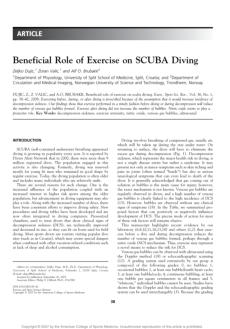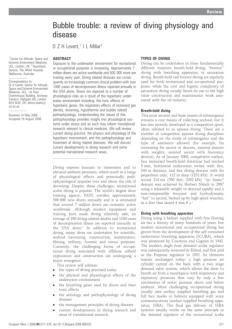Scientific papers 2007 - 2008

Authors: E. Bardy, J. Mollendorf, D. Pendergast
This document describes active heating/cooling
experiments to thermally sustain a human subject
submerged in 10, 20, 30, and 40ºC water.

This paper has been published by the department of
anesthesiology of the university of Auckland (New
Zealand), and the Naval experimental diving unit, Panama
City, Florida, USA.



Authors: O. Hyldegaard, J. Madsen
In this report, the authors visually followed the in vivo
resolution of micro-air bubbles injected into adipose tissue
of anesthetized rats decompressed from 101.3 kPa to and
held at 71 kPa corresponding to 2.750 m above sea level,
while the rats breathed air, oxygen, heliox (50:50), or
heliox (80:20).


Diving-related pulmonary effects are due mostly to
increased gas density, immersion-related increase in
pulmonary blood volume, and (usually) a higher inspired
PO2. Higher gas density produces an increase in airways
resistance and work of breathing and a reduced
maximum breathing capacity. An additional mechanical
load is due to immersion, which can impose a static
transrespiratory pressure load as well as a decrease in
pulmonary compliance.


Authors: Nico A.M. Schellart, Jan-JaapBrandt Corstius,
Peter Germonpré, and Wouter Sterk.
It is claimed that performing a “deep stop,” a stop at about
half of the maximal diving depth (MDD), can reduce the
amount of detectable precordial bubbles after the dive
and may thus diminish the risk of decompression sickness.
In order to ascertain whether this reduction is caused by
the deep stop or by a prolonged decompression time, the
team wanted to test the “deep stop” theory without
increasing the total decompression time.


The presence of gas bubbles in the vascular system is
often considered a sign of decompression stress and
several studies in the existing literature have addressed the
relationship between the amount of bubbles detected by
ultrasound Doppler systems and the incidence of
decompression sickness. The use of ultrasound imaging
has some important advantages to Doppler systems, and
here the authors have looked at the relationship between
the amount of intravascular gas bubbles detected by
ultrasound echocardiography and the incidence of signs
and symptoms of decompression stress after 203 air dives.
They conclude that bubble detection by ultrasonic
scanning of the heart can be used as a tool to assess the
safety of decompression procedures for air dives.


Authors:
Ksenya Katsenelson, Yehuda Arieli, Amir Abramovich,
Moshe Feinsod, Ran Arieli.
The authors hypothesized that the number of bubbles
evolving during decompression from a dive, and therefore
the incidence of decompression sickness (DCS), might be
reduced by pretreatment with hyperbaric oxygen (HBO).
The inert gas in the gas micronuclei would be replaced by
oxygen, which would subsequently be consumed by the
mitochondria. To investigate whether their hypothesis
holds for mammals, the authors pretreated rats with HBO
at 304, 405, or 507 kPa for 20 min, after which they were
exposed to air at 1,013 kPa for 33 min and decompressed
at 202 kPa/min.


Exercising before, during, or after diving is proscribed
because of the assumption that it would increase the
incidence of decompression sickness. The authors say that
their findings show that exercise performed in a timely
fashion before diving or during decompression will
reduce the number of venous gas bubbles formed.
Exercise after diving did not increase the number of
bubbles. The authors also say that nitric oxide seems to
play a protective role.


Author: Keith A. Gault (US Navy)
Generation III Air Navy Dive Computers (AIR III) were used
to record 315 ship husbandry dives conducted by divers
breathing air at the Puget Sound Naval Shipyard from
November 2007 to January 2008. For each profile,
decompression status was assessed from the air tables in
Rev. 6 of the U.S. Navy Diving Manual, and from the AIR
Ills, thirty-five dives were repetitive dives (within 12 hours
of previous exposure), so 280 are distinct profiles for
analysis.


Abstract:
Exposure to the underwater environment for
recreationalor occupational purposes is increasing.
Approximately 7 million divers are active worldwide and
500 000 more are training every year. Diving related
illnesses are consequently an increasingly common clinical
problem with over 1000 cases of decompression illness
reported annually in the USA alone.


Authors: Jean-Eric Blatteau, Alain Boussuges, Emmanuel
Gempp, Jean-Michel Pontier, Olivier Castagna, Claude
Robinet, Francois-Michel Galland, Lionel Bourdon.
Sixteen trained military divers, aged 27–39 years, were
compressed in a hyperbaric chamber to 400 kPa for 30
min and decompressed at a rate of 100 kPa/min with a 9
min stop at 130 kPa (French Navy MN90 procedure).
Each diver performed two dives three days apart, one
without exercise and one with exercise before the dive. All
participants performed a 40 min constant-load
submaximal and calibrated exercise, which consisted of
outdoor running two h before the dive. Circulating
bubbles were detected with a precordial doppler at 30,
60, and 90 min after surfacing. Haemodynamic changes
were evaluated with doppler echocardiography.


Authors: Andreas Møllerløkken, Christian Gutvik, Vegard J.
Berge, Arve Jørgensen, Are Løset, and Alf O. Brubakk.
There is a relationship between gas bubble formation in
the vascular system and serious decompression sickness.
Hence, control of the formation of vascular bubbles
should allow safer decompression procedures.
Twelve pigs were randomly divided into an experimental
group (EXP) and a control group (CTR) of 6 animals each.
The pigs were compressed to 500 kPa (5 ATA) in a dry
hyperbaric chamber and held for 90 min bottom time
breathing air. CTR animals were decompressed according
to a modified USN dive profile requiring four stops. EXP
followed the same profile except that 5-min
recompression of 50 kPa (0.5 ATA) was added at the end
of each of the last three decompression stop before
ascending to the next stop depth.


Authors: C. A. Duplessis, D. Fothergill, D. Shwaller, J.
Gertner.
Nitric oxide (NO) may decrease bubble formation in
diving. Statin medications are attractive potential options
to increase NO. Statins exhibit a proven safety profile and
possess a myriad of pleiotropic properties improving
vascular endothelial function. Additionally, statin-mediated
lipid reduction may reduce bubble generation via
alterations in plasma surface tension. The authors
investigated the efficacy of atorvastatin as a
pharmacological intervention to reduce the risk of bubble
formation after diving, a surrogate for decompression
sickness (DCS).


Authors: E Gempp, J E Blatteau, J-M Pontier, C Balestra, &
P Louge.
To investigate whether pre-hydration 90 minutes before a
dive could decrease bubble formation and evaluate the
consequent adjustments in plasma volume (PV), water
balance, and plasma surface tension (ST), eight military
divers participated in a crossover trial of pre-dive hydration
using saline–glucose beverage, and a controlled dive with
no pre-hydration. Drink volume was 1300 ml and drinking
time was 50–60 min. The diving protocol consisted of an
open sea field air dive at 30 msw depth for 30 min
followed by a 9 min stop at three msw. Haemodynamic
parameters, body weight measurements, urine volume,
and blood samples were taken before/after fluid intake
and after the dive. Decompression bubbles were
examined by a precordial pulsed Doppler.


This review aims to outline advances addressing the role
that reactive species of oxygen and nitrogen play in the
therapeutic mechanisms of hyperbaric oxygen. The study
will be organized around major categories of problems or
processes where controlled clinical trials have
demonstrated clinical efficacy for hyperbaric oxygen
therapy. Reactive species are now recognized to play a
major role in cell signal
transduction cascades, and the discussion will focus on
how hyperbaric oxygen acts through these pathways to
mediate wound healing and ameliorate postischemic and
inflammatory injuries.


Authors: Jean- Éric Blatteau, Emmanuel Gempp,
Costantino Balestra, Tony Mets, and Peter Germonpre.
This study investigated the influence of a far infrared-ray
dry sauna-induced heat exposure before a simulated dive
on bubble formation, and examined the concomitant
adjustments in hemodynamic parameters.


Authors: T. Randsøe, T. M. Kvist, and O. Hyldegaard
The authors of this report visually followed the in vivo
changes of micro air bubbles injected into adipose tissue
of anesthetized rats at 101.3 kPa (sea level), after which
they were decompressed from 101.3 kPa to and held at
25 kPa (10,350 m), during breathing of oxygen or a heliox
(34:66) mixture (34% helium and 66% oxygen).
Furthermore, bubbles were studied during oxygen
breathing preceded by a 3-h period of preoxygenation to
eliminate tissue nitrogen before decompression.







Authors: O. Hyldegaard, T. Jensen
To monitor the effects of heliox, oxygen, and air on helium
bubbles, helium bubbles from saturated rat adipose tissue
were studied at 101.3 kPa (1.013 bar) during breathing of
either heliox (80:20), 100% oxygen, or air after
decompression from exposure to heliox at 405 kPa (4.05
bar) for one hour.


Author: Ran Arieli
It has been shown that the solubility of a gas in water
equilibrated with a mixture of gases is not, as postulated
by Henry’s law, a linear function of the gas pressure. This
phenomenon was explained by the effect of one
dissolved gas on the stabilization or destabilization of the
water structure, which affects the saturation solubility of
another gas. The theory suggests that reduced stability will
decrease the saturation solubility.


Author: R B Wienke
This small document from R B Wienke continues the
paper above from Ran Arieli. It relates experiments made
in the USN Los Alamo laboratory on Arieli’s query about
reduced solubility and risk for mixed gas diving.


This small study records the various contaminants that can
be found in compressed gas and the control measures to
implement to eliminate them.


Authors: . Arieli, P. Svidovsky, and A. Abramovich
Trimix (a mixture of helium, nitrogen, and oxygen) has
been used in deep diving to reduce the risk of high-
pressure nervous syndrome during compression and the
time required for decompression at the end of the dive.
There is no specific recompression treatment for
decompression sickness (DCS) resulting from trimix diving.
This study aimed to validate a rat model of DCS on
decompression from a trimix dive and to compare
recompression treatment with oxygen and heliox (helium-
oxygen).


Authors: Leigh A. Madden, Gerard Laden
In this study, the authors hypothesize that gas bubbles are
not the causative agent in the progression of DCI, rather
an exacerbating factor. Endothelial dysfunction caused by
a temporary loss of haemostasis due to increased total
oxidant status is postulated to be the cause in this at-depth
endothelial dysfunction hypothesis.



Authors: Melissa K. Brown & David C. Willms
The medical use of helium-oxygen mixture (heliox) was
first described as a therapy for asthma and airway
obstructions in 1934 by Barach. Heliox applications have
expanded from airway obstruction and asthma to
bronchiolitis and chronic obstructive pulmonary disease
(COPD). Helium is an odorless, colorless, non-combustible,
biologically inert gas, and has other physical properties
that make it medically useful when mixed with oxygen.


Authors: Nico A.M. Schellart , Jan-Jaap Brandt Corstiu,
Peter Germonpré, & Wouter Sterk
It is claimed that performing a “deep stop” a stop at about
half of maximal diving depth (MDD), can reduce the
amount of detectable precordial bubbles after the dive
and may thus diminish the risk of decompression sickness.
To ascertain whether this reduction is caused by the deep
stop or by a prolonged decompression time, the authors
tested the “ deep stop ” theory without increasing the
total decompression time.


Authors: Pal Pacher, Joseph S. Beckman, Lucas Liaudet
Nitric oxide (NO) is an omnipresent intercellular
messenger in all vertebrates, modulating blood flow,
thrombosis, and neural activity. The biological production
of NO is also essential for nonspecific host defense, but
NO is unlikely to kill intracellular pathogens and tumors
directly. Although NO is often highly toxic and reactive, it
is not. In addition, NO can be produced for 80 years by
neurons in the human brain without overt toxicity.
Paradoxically, the production of the same molecule can
become highly damaging to the same neurons within a
few minutes during pathological challenges occurring
after cerebral ischemia.


Authors:
John A. S. Ross, Jennifer I. Macdiarmid, Liesl M. Osman,
Stephen J. Watt, David J. Godden, and Andrew Lawson
A postal survey sent to 2958 male professional divers,
registered with the UK Health & Safety Executive (HSE)
before 1991, and 2708 men who had worked in the
offshore oil industry in 1990–92 (non-divers). The
questionnaire addressed lifestyle, occupation and health
status.



Authors: Wayne A. Gerth & David J. Doolette
The Thalmann Algorithm VVal-18 was a decompression
algorithm developed at the Navy Experimental Diving
Unit (NEDU) to produce 0.7 atmospheres absolute (ata)
constant PO2 -in-N2 decompression schedules. It was
used with a modified VVal-18 parameter set, designated
VVal-18M. This report documents the modifications to the
VVal-18 parameter set that resulted in VVal-18M and
described the accompanying updates to the Thalmann
Algorithm that were required to implement these
modifications correctly.


Author: John Hedley-Whyte
At sea level, oxygen is toxic to man when breathed for
more than twenty-four hours at a percentage greater
than forty percent. Pulmonary pathology is the first
manifestation in subjects with previously normal lungs. In
patients with pre-existing lung disease, the results are
often additive. There is, however, significant variation in
response from subject to subject and between patients.
Queen’s Belfast and Harvard University Medical Schools
have been the site of seminal investigations. Mentoring at
both universities is due to training at the University of
Copenhagen.


Author: Barbara Shykoff
This paper reports tests performed for four-hour dives,
including underwater exercise at PO2 = 1.3 atm with 20-
hour surface intervals between dives and three-hour dives
with 21-hour intervals. Doctor Shykoff concluded that
pulmonary changes do not accumulate with three-hour
dives with exercise at Pot = 1.3 atm when divers have 21
hours between dives and that this diving schedule can be
repeated indefinitely.


Authors: F. K. Butler, C. Hagan, H. Murphy-Lavoie
This paper is a review of HBOT (Hyperbaric Oxygen
Treatment) for ocular indications.
Because some ocular disorders require rapid
administration of HBOT to restore vision, patients with
acute vision loss should be considered emergent when
they present. Visual acuity should be checked
immediately.


Authors:
Dror Tal, Peter Gilbey, Ronen Bar, and Avi Shupak
Seasickness is thought to result from conflicting inputs
from the vestibular, visual and somatosensory systems.
The otolithic organs, which are responsible for the
sensation of linear acceleration and tilt, are important in
the pathogenesis of seasickness. The vestibular evoked
myogenic potentials test is an objective evaluation of
saccular function.
The objective of this study is to examine whether saccular
function is related to the pathogenesis of seasickness.


Author: Valerie Flook
This report derives from and clarifies those published by
Unimed Scientific Ltd in 2002 and 2003 for “Well Ops UK
Ltd”. The major part of the work was carried out for UK
Health and Safety Executive, and the report is available
from the HSE web site as research report number RR244.


Authors: Akin Savas Toklu, Sefika Korpinar, Mustafa Erelel,
Gunalp Uzun, Senol Yildiz
Air cysts or blebs in the lungs may predispose pulmonary
barotrauma (PBT) by causing air trapping when there is a
change in environmental pressure. The changes in the
environmental pressure are also seen during hyperbaric
oxygen treatments (HBOT).
The aim of this study was to determine how patients were
evaluated for pulmonary blebs or bullae, and PBT
prevalence in different HBOT centers.
HBOT centers were asked to participate in this study, and
a questionnaire was sent via e-mail, to which 98 centers
responded.


Authors:
Tiina M. Makinen, Raija Juvonen, Jari Jokelainen, Terttu H.
Harju, Ari Peitso, Aini Bloigu, Sylvi Silvennoinen-Kassinen,
Maija Leinonen, Juhani Hassi
This study examined whether the development of acute
respiratory tract infections (RTIs) is potentiated by cold
exposure and lowered humidity in a northern population.
It should be linked to the humidity level in the diving
breathing gasses.


Authors: Alison C. Ma, and Neal W. Pollock
Diver selection is primarily based on medical fitness and
physical competency criteria. Physical competency is
generally evaluated through certification records and
initial tests of swimming skills and in-water diving abilities.
Continuation of active status requires periodic medical
evaluations, current emergency care certifications, and
documentation of diving activity exceeding minimum
requirements. While individual institutions and programs
may require additional evaluations, formal requirements
for periodic assessment of physical fitness are notably
absent from most standards


Publisher: Undersea and Hyperbaric Medical Society
This document is the proceedings of a workshop held at
the Salt Palace Convention Center in Salt Lake City, Utah,
USA, in June 2008.


Click on the octopus
to return to the top
of the page



Author: Saul Goldman
Compartmental models have long been used in medicine
to study how different substances clear out of the body.
These models have been updated to help predict safe
decompression times for divers. The new models include a
main compartment that directly impacts safety and one or
two secondary compartments that exchange gases with
the main compartment. Studies show that models with
three compartments are more accurate than those with
two. This finding could change diving practices if further
tests confirm the models' predictions.


Author: Neal W Pollock
Techniques for ultrasound assessment of decompression
stress continue to evolve with technological
advancements.
While aural Doppler remains the standard, imaging
techniques are becoming increasingly popular. Current
initiatives to increase the resolution of three-dimensional
and dual-frequency imaging promise to expand our
monitoring capabilities further. Understanding the
limitations and strengths of ultrasound assessment is
essential for interpreting existing decompression studies
and designing new studies.


Auhor: Steve Selvin
This practical guide to survival data analysis is designed for
readers with a basic understanding of statistics. It explains
the rationale behind the analytic methods and shows
how to effectively analyze and interpret epidemiological
and medical survival data using modern computer
systems.


Authors: Peter Lindholm, & Claes EG Lundgren
This overview covers the physiological reactions,
limitations, and pathophysiological mechanisms linked to
breath-hold diving. Despite approaching physiological
limits, as evidenced by post-dive pulmonary issues, the
pursuit of performance enhancement continues. The
discussion includes the diving response of the
cardiovascular system, respiratory challenges, mechanisms
related to hypoxia and loss of consciousness, and the risks
of decompression sickness and narcosis due to high
nitrogen pressure in the lungs.












